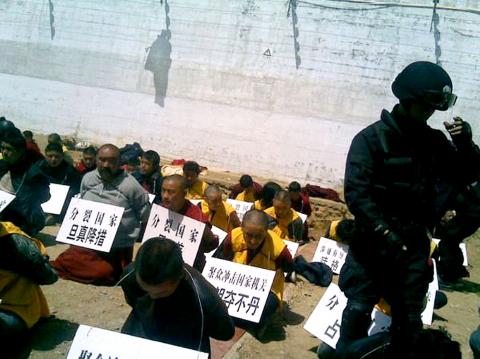Recently leaked footage of a crackdown by Chinese security forces in Tibet indicates that the level of repression against Tibetans appears to be much more serious than generally acknowledged by the international community.
A video posted on the exile Tibetan Web site TibetOnline.tv on Wednesday showed a raid by a Chinese SWAT team comprising about 100 People’s Armed Police (PAP) officers on what is believed to be Unit 2 of Dode Village, near the Sera monastery northeast of Lhasa.
The quality footage, which is believed to have been shot in 2008, displays an unprecedented show of force by Chinese authorities, with SWAT teams, accompanied by numerous dogs and an armored vehicle, assuming attack formation and aiming assault rifles at sleeping villagers. In all, four confused-looking men and one elderly woman are taken away. Each is forced to stare into the camera and provide details to the cameraman, who is presumably a PAP member.

Photo: AFP
Unlike previous unrest, such as the 1989 riots in Lhasa or the March 2008 incident, during which nervous and sometimes vengeful PAP officers were confronted with an emergency, the troops in the video are not responding to any immediate threat.
As of last evening, the 22-minute video appeared to have been taken offline. It has since emerged on YouTube.
The material follows the release on the citizen journalism Boxun Web site last week of eight photographs showing Tibetan prisoners being paraded by a large contingent of armed police in China’s Sichuan Province, also in 2008 or later.
The two releases have led analysts to conclude that someone in China, perhaps within the security apparatus, is leaking information to show the true scale of repression in Tibet and neighboring areas in China.
Reacting to the video, Dawa Tsering, chairman of the Tibet Religious Foundation of His Holiness the Dalai Lama — the de facto representative of the exiled government in Taiwan — said that the way in which Chinese treat Tibetans showed them to be a conquered and colonized people.
“Any Tibetan with a heart will never forget this humiliation, we will not forget how arrogant the Chinese are and the humiliation we went through,” he said. “We will remember this for generations to come and this memory will constantly remind us of what we should do.”
Former Regional Tibetan Youth Congress Taiwan president Tashi Tsering said he was not surprised by what Chinese police officers did to Tibetans.
“That’s how the Chinese Communist Party has always treated Tibetans,” Tashi said via telephone. “The Chinese always claim they respect human rights, but what they do is different from what they say. Taiwanese should know this and be very careful when dealing with China.”
He called on the international community to launch a probe into human rights violations in Tibet.
Additional reporting by Loa Iok-sin

Tropical Storm Gaemi strengthened into a typhoon at 2pm yesterday, and could make landfall in Yilan County tomorrow, the Central Weather Administration (CWA) said yesterday. The agency was scheduled to issue a sea warning at 11:30pm yesterday, and could issue a land warning later today. Gaemi was moving north-northwest at 4kph, carrying maximum sustained winds near its center of up to 118.8kph and gusts of 154.8kph. The circumference is forecast to reach eastern Taiwan tomorrow morning, with the center making landfall in Yilan County later that night before departing from the north coast, CWA weather forecaster Kuan Shin-ping (官欣平) said yesterday. Uncertainty remains and

SEA WARNING LIKELY: The storm, named Gaemi, could become a moderate typhoon on Wednesday or Thursday, with the Taipei City Government preparing for flooding A tropical depression east of the Philippines developed into a tropical storm named Gaemi at 2pm yesterday, and was moving toward eastern Taiwan, the Central Weather Administration (CWA) said. Gaemi could begin to affect Taiwan proper on Tuesday, lasting until Friday, and could develop into a moderate typhoon on Wednesday or Thursday, it said. A sea warning for Gaemi could be issued as early as Tuesday morning, it added. Gaemi, the third tropical storm in the Pacific Ocean this typhoon season, is projected to begin moving northwest today, and be closest to Taiwan on Wednesday or Thursday, the agency said. Today, there would likely

DISRUPTIONS: The high-speed rail is to operate as normal, while several airlines either canceled flights or announced early departures or late arrivals Schools and offices in 15 cities and counties are to be closed today due to Typhoon Gaemi, local governments announced last night. The 15 are: Taipei, New Taipei City, Taoyuan, Tainan, Keelung, Hsinchu and Kaohsiung, as well as Yilan, Hualien, Hsinchu, Miaoli, Chiayi, Pingtung, Penghu and Lienchiang counties. People should brace for torrential rainfall brought by the storm, with its center forecast to make landfall on the east coast between tonight and tomorrow morning, the Central Weather Administration (CWA) said. The agency issued a sea warning for the typhoon at 11:30pm on Monday, followed by a land warning at 11:30am yesterday. As of

CASUALTY: A 70-year-old woman was killed by a falling tree in Kaohsiung as the premier warned all government agencies to remain on high alert for the next 24 hours Schools and offices nationwide are to be closed for a second day today as Typhoon Gaemi crosses over the nation, bringing torrential rain and whipping winds. Gaemi was forecast to make landfall late last night. From Tuesday night, its outer band brought substantial rainfall and strong winds to the nation. As of 6:15pm last night, the typhoon’s center was 20km southeast of Hualien County, Central Weather Administration (CWA) data showed. It was moving at 19kph and had a radius of 250km. As of 3pm yesterday, one woman had died, while 58 people were injured, the Central Emergency Operation Center said. The 70-year-old